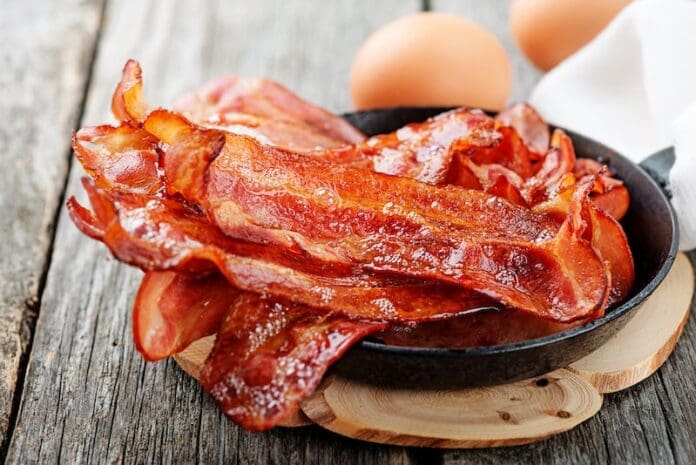
Bacon, with its rich flavor and irresistible aroma, has long been a favorite in kitchens worldwide. Its versatility allows it to enhance a variety of dishes, from breakfast to dinner and everything in between.
This article aims to provide you with practical tips for cooking bacon to perfection. Whether you’re a novice cook or a seasoned chef, these tips will help ensure that your bacon is always cooked just right, adding the perfect touch to every recipe.
Choose The Right Type Of Bacon
Selecting the right type of bacon can greatly influence the outcome of your dish. For a crunchy topping or a crispy side dish, gourmet streaky bacon, with its generous fat layers, is an excellent choice. Its ability to render a perfect crispiness makes it a versatile ingredient in various recipes. On the other hand, back bacon, leaner and subtler, is well-suited for dishes where bacon acts as a gentle accent rather than the centerpiece.
Moreover, the thickness of the bacon cut plays a crucial role. Thick-cut bacon offers a chewier, meatier bite, perfect for heartier dishes like burgers or stews. In contrast, thinner slices crisp up quickly, making them ideal for wrapping around other ingredients or adding a delicate crunch to salads and pastas. Understanding these nuances ensures your bacon choice enhances the dish, balancing flavor and texture in harmony.
Use The Right Cooking Method
Choosing the appropriate cooking method for bacon can significantly impact its texture and flavor, complementing the dish it accompanies. Pan-frying is a classic method, ideal for achieving a crispy texture quickly. It’s suitable for breakfast dishes or when you want the bacon to be the star with its rich, savory flavor.
Alternatively, baking bacon in the oven offers a more hands-off approach, uniformly cooking larger batches without splattering grease. This method works well for recipes requiring evenly cooked, straight bacon strips.
Grilling bacon, meanwhile, adds a unique smoky flavor, perfect for outdoor barbecues or adding a rustic touch to burgers and sandwiches. Each method brings out different qualities in bacon, making it essential to match the cooking technique with the recipe’s needs.

Manage The Cooking Temperature
Managing the cooking temperature is crucial in achieving the perfect texture in bacon. Cooking bacon at a lower temperature allows the fat to render slowly, leading to evenly crispy strips without burning. This gentle cooking process is key for a tender yet crunchy texture that is not overly hard or brittle.
On the other hand, a higher temperature might be suitable for quickly searing the bacon, resulting in a robust flavor and a slightly chewier texture. This method is ideal for dishes where bacon is used as a flavorful accent rather than the main component. Paying attention to the temperature ensures that the bacon’s texture aligns with the specific needs of the recipe, enhancing the overall culinary experience.
Avoid Overcrowding The Pan
When cooking bacon, it’s important to give each piece enough space in the pan. Overcrowding can lead to uneven cooking, with some parts undercooked and others overdone. This happens because the bacon strips can’t lay flat, preventing the heat from distributing evenly. As a result, you might end up with bacon that’s not uniformly crispy or properly rendered.
To avoid this, consider cooking bacon in batches, especially when preparing large quantities. This approach ensures that each piece cooks evenly and achieves the desired texture. It might take a bit more time, but the outcome is consistently well-cooked bacon that enhances your dish with its perfect texture and flavor.
Drain Excess Fat
Draining excess fat from cooked bacon is an essential step for achieving a crispier texture and a healthier meal. As bacon cooks, it releases fat, which, if not removed, can leave the bacon soggy and overly greasy. To prevent this, place the cooked bacon on a paper towel-lined plate immediately after cooking. The paper towel absorbs the excess fat, resulting in a crispier and more appealing texture.
Additionally, draining the fat can make your bacon more suitable for those mindful of their fat intake. This simple yet effective technique does not compromise the bacon’s flavor but enhances its texture and aligns with healthier eating practices. It’s a small step that makes a significant difference in the overall quality and enjoyment of your dish.
Experiment With Seasonings
Experimenting with seasonings can transform the flavor of bacon, elevating it from a simple ingredient to a standout component in any recipe. While bacon’s natural taste is delightful, adding spices and herbs can infuse it with unique flavors. For a sweet twist, try coating bacon with a little brown sugar or maple syrup before cooking. These sweeteners caramelize, creating a deliciously rich glaze.
For those who prefer a savory or spicy kick, consider rubbing the bacon with black pepper, paprika, or cayenne. Herbs like rosemary or thyme can also add a fragrant dimension. This experimentation with different seasonings allows bacon to seamlessly fit into a wider range of cuisines and dishes, offering a delightful surprise to the palate.
Conclusion
Mastering the art of cooking bacon is about paying attention to small details. Whether you’re selecting the right type, managing the temperature, or experimenting with seasonings, each step contributes to creating the perfect piece of bacon. Remember, great bacon can elevate any dish, adding a touch of savory delight that is hard to resist.
